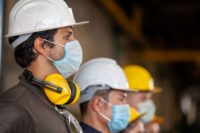The supply chain is a part of every industry. Businesses, manufacturing plants and factories must be operational to keep supply chains going for food, technology and all types of commerce. With COVID-19 disrupting the entire world, safety is now a top priority.
As industries start their shutdown reopenings, following OSHA standards and other COVID-19 reopening protocols from authorities is critical.
OSHA
The Occupational Safety and Health Administration (OSHA) is one of the best resources when it comes to information for industry. The guidelines it has released relate to manufacturing as a whole. Following these protocols is essential for any shutdown reopening.
Some key factors to keep in mind are sanitation and hygiene, social distancing and communication. Increased sanitation is necessary — with nonessential workers coming back, boosting cleaning practices ensure fewer risks of COVID-19 transmission.
Additionally, personal protective equipment (PPE) like masks, gloves and plexiglass dividers keep workers safe. Masks must cover the nose and mouth, and workers should limit contact by socially distancing at least six feet apart.
Finally, having staff and workers communicate about any symptoms, contact with the infected and recent travel is key. Honesty will keep the workplace safe while following OSHA standards.
CDC
The Centers for Disease Control and Prevention (CDC), alongside the World Health Organization (WHO), are two excellent primary resources for COVID-19 information. From sanitation to workers' rights, these guidelines are necessary to follow.
The CDC protocols involve covering the bases for all staff and employees. They include the same general principles as OSHA and build further upon them. With workplace procedures, for instance, the CDC calls on businesses to screen for the virus by taking temperatures and monitoring contact between employees.
Consistent sanitation and disinfecting are both critical as well. Additionally, the CDC popularized the mantra to wash one's hands frequently, with antibacterial soap, for at least 20 seconds. This step is simple and easy to follow for protection.
Returning to work, too, must have fleshed-out protocols. Whether it's nonessential workers or those who have beaten the virus, anyone who returns must follow strict social distancing and use PPE. They must avoid sharing equipment and transportation as well.
Safety officers and managers must take workers' rights into account during this time. Paid time off and paid sick leave are critical benefits when workers must stay home or quarantine themselves. Employees who cannot afford to stay home if they fall ill pose a danger to the entire workforce.
Manufacturing Leadership Council
In terms of industry work, the Manufacturing Leadership Council is one of the top resources when it comes to reliable information. For the coronavirus pandemic, the council focuses on factory- and facility-specific practices.
As OSHA and the CDC dictate, limiting contact is essential. The council expands on that and suggests that there should be no sharing of any tools in the workspace. Even keyboards can have covers for protection. Limiting touch in common areas like doors or tables is also a must.
Additionally, communication through digital means instead of in-person may be a smart action to implement. Alongside, flexible shifts and scheduling, texting or calling helps reduce congestion and congregation.
Since different states have fluctuating virus severities, COVID-19 reopening will look different in each location. While some states are providing reopening information for industries and businesses, other states are shutting down again.
IEDC
The International Economic Development Council (IEDC) manages an organization called Restore Your Economy. Here, the two groups focus on the economic impacts on industry work that COVID-19 has caused.
With 30 million Americans filing for unemployment, the United States is in an economic recession. This dynamic causes a shift in the supply chain, which the IEDC suggests managers should focus on strengthening during this time.
Furthermore, small and mid-sized businesses and manufacturers have taken a hit from this pandemic. Focusing on restarting all industries will lead to more economic prosperity. A significant part of safety and security involves finances. With the right funding and benefits for employees, factories and plants can operate properly.
Following the Guidelines
Whether it is OSHA standards or protocols from the CDC, a shutdown reopening must adhere to the strictest regulations.
Sanitation and hygiene, financial support, social distancing and PPE and COVID-19 reopening protocols are necessary aspects to include. Then, businesses and manufacturers can return to a new normal with improved production.








.jpg?t=1721257160)
